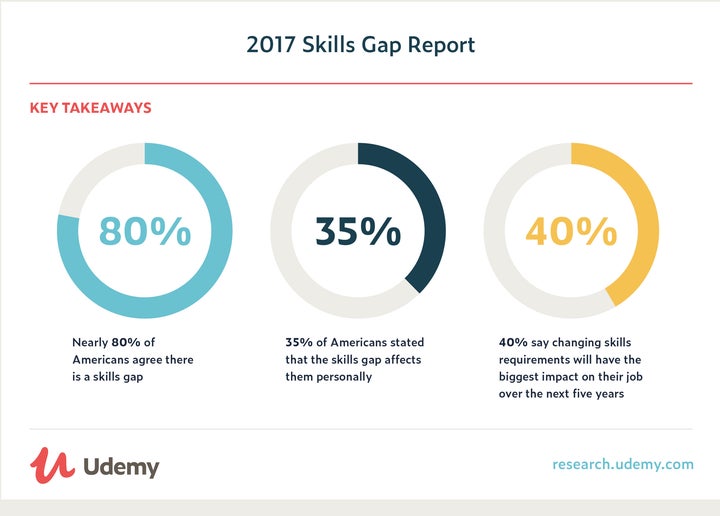
Employers are struggling to fill a record number of U.S. job openings. They’ve floated a few reasons why finding qualified new hires is so hard right now: Americans don’t have the skills required to perform these jobs; traditional education isn’t teaching the right skills; government isn’t doing enough to get people into skills training programs so our country can remain competitive and productive.
Research conducted by Udemy may be enlightening to these employers. Our 2017 Skills Gap Report found that American workers are actually pretty confident about their current skill sets and believe their education prepared them well. They’re well-aware of the skills gap but most don’t see it as a personal issue yet.
At the same time, employees do recognize that the skills required to do their jobs will likely change in the next few years, and they do have concerns about the future. In fact, many are already taking action on their own, such as paying out of their own pockets for online courses, workshops, bootcamps, and so on.
But Udemy’s 2017 Skills Gap Report makes it clear that they’re really looking to employers to support them in their learning journey. In our survey, 27% said employers bear the most responsibility for reskilling, while only 20% point to government and 17% to traditional educational institutions.
According to the 2017 Training Industry Report, companies spent an average of $1,075 per learner. That’s a decent start, but some companies also spend $3-$8 per employee every day on office snacks, which is well over $1000 a year. Which enhances overall performance more: potato chips or job skills?
There’s a strong business case to be made for increasing the investment in L&D and building a learning culture. Here are just a few of the benefits:
- Close your own skills gap: Instead of searching high and low for a new hire, encourage your existing talent to grow their skills. Too often, companies only let employees take training on skills directly connected to their current roles, but this is a missed opportunity. When you let avid learners stretch and follow their curiosity, they can contribute in more places and even fill holes in your headcount.
- Increase employee engagement: For Udemy’s 2016 Workplace Boredom Report, 80 percent of employees agreed that “being given opportunities to learn new skills at work would make me more interested and engaged in my job.” Engaged employees are more productive, creative, and collaborative.
- Increase employee retention: There’s a meme that’s floated around the internet where a CFO asks the CEO, “What happens if we invest in developing our people and they leave?” And the CEO responds, “What happens if we don’t, and they stay?” This sums up the value of corporate learning quite nicely. It creates more engaged employees who perform better and stick around longer.
Employers and employees agree: the skills gap is real. There’s less direct agreement on what to do about it. But employers can’t wait for universities to churn out the grads they want, and they can’t expect government to fix the problem. The best way for companies to find the talent they need is to grow their own—and close their own skills gaps.
